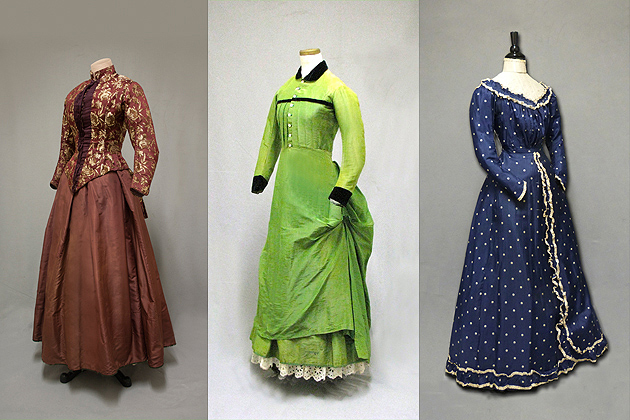
For more photos of dresses on display at the Benton Museum, go to the UConn Today Flickr gallery.
History. Fashion. Literature. Works of art. Conversation pieces. The current exhibition at the Benton Museum explores topics far more diverse than might initially be inferred from its title: Women of New England: Dress from the Industrial Age, 1850-1900.
Guest curator Laura Crow, director of costume design and professor of dramatic arts in the School of Fine Arts, and curator of the Connecticut Historical Clothing and Textile Collection, uses the display to spin a tale that includes references to Empress Eugenie, the wife of Napoleon III; Sarah Josepha Hale, the first woman editor of Godey’s Lady’s Book; and Britain’s Queen Victoria, all of whom influenced women’s fashion in the latter half of the 19th century.
“This [collection] shows how women dressed in New England in the mid- to late-1800s and it’s a real tribute to their creativity and fashion sense,” says Crow. “These were people living in a rural setting and they made their clothes by hand, from fabrics purchased locally.

She notes that the fashion magazine Harper’s Bazaar was first published in 1867 and it was available to women all over the world, so fashion became truly ‘international’ after 1868. “This is how the women who made these dresses [on display] kept up with the very latest fashion ideas,” says Crow, “and it helps explain the sophistication of their work.”
In fact, the dresses on display in the Evelyn Simon Gilman Gallery through March 11 tell the story of an evolving textile industry, including Willimantic’s American Thread Company and the Cheney Silk Mills in Manchester. They illustrate the impact of Isaac Singer’s sewing machine, a home model that could be purchased with a small down payment; and of Ebenezer Butterick’s clothing patterns that, for the first time, gave women instructions on how to sew garments in standard sizes.
Dresses in the collection include wedding gowns in colors ranging from fuchsia to white, and everyday office wear suitable for a young woman entering an expanding white-collar workforce. Whether it’s a dress with a hoop or cage crinoline, a utilitarian device popularized as a fashion accessory in France by Princess Eugenie, or the number of plaid garments, which, according to Crow, “stemmed from Queen Victoria’s near obsession with plaid,” each item in the display comes with a story linking it not only to New England, but to a larger world gripped by the seismic changes of the Industrial Revolution.
As an added bonus, just outside the gallery visitors can see a dress belonging to Edwina Whitney (1868-1970) for whom UConn’s Whitney Hall was named. Whitney was hired in 1901 for an annual salary of $500. During her years of employment, she taught German and English, and worked as campus librarian until her retirement in 1934. The Whitney family story parallels that of UConn, as it evolved from the Storrs Agricultural School to a land-grant college – complete with a robust home economics department – to its present position as a major research university.
Clothing and Textile Collection
The collection from which the items in the Benton exhibit were drawn is a hidden gem on the UConn campus. Altogether, the Connecticut Historical Clothing and Textile Collection consists of more than 8,000 items, 3,500 of which are garments.
The clothing and textiles currently share quarters with the puppetry archives on the Depot Campus, but storage space is tight and there is no room for a permanent exhibition. Crow is in the midst of creating a ‘virtual’ collection that will not only make items accessible for researchers but will also preserve the essence of the fabrics, which are beginning to suffer from the ravages of time.
The project is time consuming, as each item is conserved, placed on a custom padded dress form, and then photographed from eight different angles with a high resolution camera. Then the images are aligned in Adobe Photoshop and, finally, processed with an animation program that enables viewers to examine the image in minute detail. So far, 200 of the 3,500 garments have been prepared for the virtual museum.
An archive of 5,000 primary source historical research images taken from Crow’s photo library already exists. The archive is available to her students and members of the United States Institute for Theater Technology (USITT) for research and teacher support through a password-protected site in the Fine Arts Digital Media Archive. Anyone interested in exploring either the actual or the virtual archive is welcome to contact Crow.
Raising grant money to continue to preserve and record the garments is an ongoing process. Ultimately, it is Crow’s objective to have each of the 3,500 garments digitally preserved, along with its provenance, giving full historical details of the item together with any interesting family anecdotes that came with the garment when it was donated.
“The first donations happened at the turn of the [20th] century from students in UConn’s Home Economics Department, and then the collection grew over time as people found things in their grandmother’s attic or rescued hand-me-downs from being cut up and turned into dust rags,” says Crow. “We’ve been blessed by the generosity of a number of donors in years past, including a great many items from Beatrice Fox Auerbach, who really supported UConn. It would be wonderful if we could permanently exhibit the things we’ve been given, so everyone could enjoy them.”
The exhibition at the Benton Museum runs through March 11. Galleries are open Tuesday through Friday from 10 a.m. to 4:30 p.m., and on weekends from 1 p.m. to 4:30 p.m. Admission is free.


